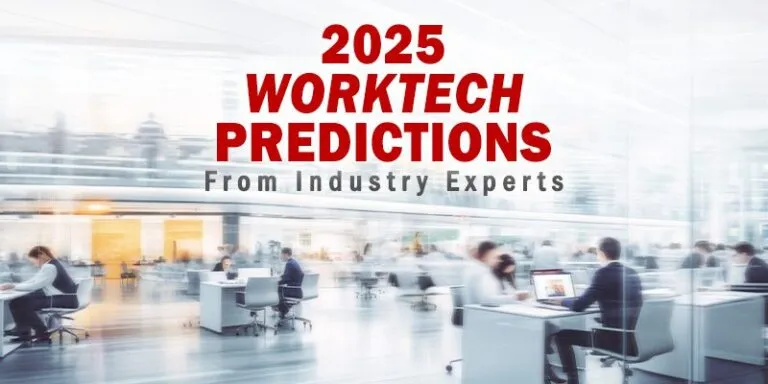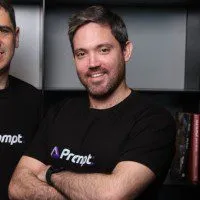53 WorkTech Predictions from Industry Experts for 2025
Blog: Best BPM Tools, Vendors, Software and BPMS

As part of this year’s Insight Jam LIVE event, the Solutions Review editors have compiled a list of predictions for 2025 from some of the most experienced professionals across the Enterprise Resource Planning (ERP), Business Process Management (BPM), and broader WorkTech marketplaces.
As part of Solutions Review’s annual Insight Jam LIVE event, we called for the industry’s best and brightest to share their ERP, BPM, CRM, and Marketing Automation predictions for 2025 and beyond. The experts featured represent some of the top WorkTech solution providers with experience in these marketplaces, and each projection has been vetted for relevance and ability to add business value.
WorkTech Predictions for 2025 and Beyond
Thomas Butta, Chief Strategy and Marketing Officer at Airship
Data willingly and simply provided will be key to unifying customer experiences.
 “While walled gardens are nothing new, the walls keep getting higher—fortified by data deprecation and growing privacy regulations. In 2025, industry giants like Meta and Google will continue to tighten their grip on audiences, keeping more traffic on their pages while scraping content for large language models without an equitable value exchange. The result: plummeting referral traffic and soaring acquisition costs.
“While walled gardens are nothing new, the walls keep getting higher—fortified by data deprecation and growing privacy regulations. In 2025, industry giants like Meta and Google will continue to tighten their grip on audiences, keeping more traffic on their pages while scraping content for large language models without an equitable value exchange. The result: plummeting referral traffic and soaring acquisition costs.
“Now more than ever, brands must prioritize direct customer relationships or risk being disintermediated. Data willingly and simply provided and purposefully solicited will be key to unifying experiences everywhere customers choose to interact–on the web, in apps, and everywhere in between.”
Mehdi Daoudi, CEO of Catchpoint
DevOps Supercharges AI-First Infrastructure in 2025
 “DevOps will evolve to meet the unique demands of AI-driven infrastructure, where complex ecosystems of data, machine learning models, and interconnected systems power nearly every industry. This AI ecosystem involves managing vast amounts of data, training and deploying machine learning models, and supporting scalable compute resources—all requiring specialized infrastructure. DevOps teams will expand their role, going beyond workflow automation to fully owning and optimizing these AI-first infrastructures. They’ll set best practices for managing the speed, scale, and reliability of AI applications, helping organizations harness AI efficiently and securely as it becomes central to operations.”
“DevOps will evolve to meet the unique demands of AI-driven infrastructure, where complex ecosystems of data, machine learning models, and interconnected systems power nearly every industry. This AI ecosystem involves managing vast amounts of data, training and deploying machine learning models, and supporting scalable compute resources—all requiring specialized infrastructure. DevOps teams will expand their role, going beyond workflow automation to fully owning and optimizing these AI-first infrastructures. They’ll set best practices for managing the speed, scale, and reliability of AI applications, helping organizations harness AI efficiently and securely as it becomes central to operations.”
Edge Compute: The New Frontier in 2025
“Edge computing will emerge as the new frontier, enabling real-time data processing closer to where it’s generated—whether in autonomous vehicles, IoT devices, or remote facilities. By minimizing latency and reducing the load on centralized cloud resources, edge computing will transform industries like manufacturing, healthcare, and retail with faster, more reliable data-driven insights. This shift empowers applications that demand ultra-low latency, increased security, and local processing capabilities, pushing businesses toward a future where edge intelligence enhances user experiences, operational efficiency, and scalability like never before.”
Bill Buckley, the SVP of Engineering at CloudZero
Cloud cost management strategies will be increasingly driven by emerging technologies like AI and containerization.
 “As more organizations adopt technologies like AI and containerization, robust visibility into their cloud costs will become even more important to make better decisions. With the use of edge content networks and more storage, organizations in 2025 will increasingly need a better handle on cloud cost management.”
“As more organizations adopt technologies like AI and containerization, robust visibility into their cloud costs will become even more important to make better decisions. With the use of edge content networks and more storage, organizations in 2025 will increasingly need a better handle on cloud cost management.”
“Engineering and finance teams will increasingly need to understand how to normalize the cost data from many providers and then understand unit economics. AI features are exciting but often are associated with significant and variable costs. Many of those costs will be worthwhile but without real-time monitoring of their unit economics, cost management teams will struggle to help their companies maximize those AI features’ reach and economic impact.
“Another factor here is that more companies are shifting to outcome-based pricing for AI products, which means pricing will be tied directly to the outcomes delivered by AI agents. As a result, you can’t set prices without understanding the cost per AI agent outcome, making a modern cloud cost management strategy essential.”
Fragmentation in the cloud.
“Companies, especially larger ones using AI, will see an increasing fragmentation in their cloud as they try out different AI services and chase where GPU and computing are available. With an explosion of exciting third-party vendors helping companies bring AI and AI-powered solutions to market, many companies will bring on new vendors in this space. Lastly, good data is the lifeblood of many of these AI trends, so companies will continue to invest in data platforms. These pressures will make it even harder for cost management teams to collect, normalize, and organize their cloud vendor costs in an actionable way.
“Increasingly, companies are looking to use tooling to assist with this data problem. Through either build or buy strategies, companies will need to deploy more software to assist in getting timely visibility into this increased vendor sprawl.”
Higher demand for real-time insights.
“Many teams are still struggling to predict cloud costs, with many lacking the right tools or knowledge to make early estimates. That could be a wake-up call for leaders with a false sense of how prepared their teams are to manage cloud costs. The good news is that we expect to see continued advancements in monitoring tools in the coming year, which should improve real-time insights. The best tools will continue to offer easy-to-leverage ETL and normalization to allow a single pane of glass across all costs. They will also, as AI spending increases, make it easier and easier to bring in non-cost spending, like revenue, to understand unit economics.”
Damantha Boteju, Chief Product and Technology Officer at Configit
Manufacturers Will Lean into Generative AI for Augmentation and Employee Enablement
 “One of the significant business benefits of Generative AI is reducing time to market while giving employees time back to work on bigger, more creative projects. Generative AI helps accelerate business processes and reduce mundane work, enabling employees to focus on being creative and putting more effort into better human interactions and collaboration. The most competitive companies in 2025 will be those who understand the power of artificial intelligence and copilots to build on the strength of their employees.”
“One of the significant business benefits of Generative AI is reducing time to market while giving employees time back to work on bigger, more creative projects. Generative AI helps accelerate business processes and reduce mundane work, enabling employees to focus on being creative and putting more effort into better human interactions and collaboration. The most competitive companies in 2025 will be those who understand the power of artificial intelligence and copilots to build on the strength of their employees.”
Daniel Joseph Barry, Vice President of Product Marketing at Configit
The Concept of the Digital Configuration Thread Gains Prominence
 “The digital thread approach is rapidly becoming the data foundation for managing both standard and configurable products. As we move into 2025, we see this concept playing an even more prominent role. That’s because a digital thread can help manufacturers by providing end-to-end insight and traceability, enabling analysis and optimization of product portfolios, and supporting digital twins. However, achieving this approach often requires manufacturers to cobble together information from multiple bills of material (BOMs) in varying formats that reside in disparate systems–typically under the purview of multiple departments. That can lead to misunderstandings, inconsistencies, control issues, and maintenance concerns, but Configuration Lifecycle Management (CLM) produces a ‘digital configuration thread’ that can help manufacturers manage product configurations better.”
“The digital thread approach is rapidly becoming the data foundation for managing both standard and configurable products. As we move into 2025, we see this concept playing an even more prominent role. That’s because a digital thread can help manufacturers by providing end-to-end insight and traceability, enabling analysis and optimization of product portfolios, and supporting digital twins. However, achieving this approach often requires manufacturers to cobble together information from multiple bills of material (BOMs) in varying formats that reside in disparate systems–typically under the purview of multiple departments. That can lead to misunderstandings, inconsistencies, control issues, and maintenance concerns, but Configuration Lifecycle Management (CLM) produces a ‘digital configuration thread’ that can help manufacturers manage product configurations better.”
Manufacturers Will Look to Configuration to Help with Workforce Challenges
“Demands on manufacturers have never been higher, but U.S. manufacturers are struggling with a workforce gap. As seasoned workers hit retirement age, manufacturers will need to ensure they can capture the institutional knowledge of these employees in a more efficient way. That means moving away from a document- and experience-driven process to capture information from individual contributors. A configuration lifecycle management approach is one approach to doing this, laying the foundation for better collaboration and innovation by centralizing product configuration information so it can be shared among multiple departments. This capability lessens the sting of retiring pros and the fear of losing a company’s ‘brain trust.'”
Henrik Hulgaard, Vice President of Product Management at Configit
Configurability Will Become a Bigger Priority
 “As we saw in a recent survey of Product Lifecycle Management (PLM) professionals conducted by CIMdata, configurability has become a bigger priority, and we anticipate that trend will continue in 2025. This will drive the need for new ways to support customization, as traditional processes and tools won’t suffice. Many manufacturers still try to manage configurable products and product variants as if they were standard products, but managing configurable products requires a different approach. This leads to the next prediction.”
“As we saw in a recent survey of Product Lifecycle Management (PLM) professionals conducted by CIMdata, configurability has become a bigger priority, and we anticipate that trend will continue in 2025. This will drive the need for new ways to support customization, as traditional processes and tools won’t suffice. Many manufacturers still try to manage configurable products and product variants as if they were standard products, but managing configurable products requires a different approach. This leads to the next prediction.”
The Adoption of Modularity Will Rise
“We’ll see an increase in modularity due to the expanded demand for customization and increased regulations and compliance mandates. For instance, sustainability regulations that require reuse and recyclability, such as those we see in the U.S. and EU, are easier to meet with a modular approach. Many early adopters have already implemented a modular approach to their products, and we’ll see more adoption in the new year, as modularity benefits manufacturers by reducing time, effort, and costs. It enables them to meet customization demands more cost-effectively by reusing modules (collections of features or pre-assembled parts) rather than custom engineering.
“Adopting modularization can be demanding, as it requires process changes, but with the combined compelling events of regulations and competition, manufacturers can justify the investment and reap the benefits. Forward-thinking manufacturers have already recognized this and are adopting new approaches centered on modularity and transitioning from engineer-to-order (ETO) to more customize-to-order (CTO) approaches that better meet their customers’ needs and enable faster response and delivery of solutions with minimal impact on engineering resources.”
Steve Rotter, Chief Marketing Officer at DeepL
AI will accelerate hyper-personalized, more consistent marketing.
 “We live in a hyper-personalized world—custom coffee, made-to-order clothing, and on-demand news feeds. Brands are even now tailoring their marketing messages and language to every customer in their preferred language, style, and tone. Along with personalization, consistency of language across all streams is central to successful marketing. Research shows that it boosts revenue by 20 percent or more.
“We live in a hyper-personalized world—custom coffee, made-to-order clothing, and on-demand news feeds. Brands are even now tailoring their marketing messages and language to every customer in their preferred language, style, and tone. Along with personalization, consistency of language across all streams is central to successful marketing. Research shows that it boosts revenue by 20 percent or more.
“However, achieving this consistency across borders and languages is tough, requiring not only linguistic translation but also cultural adaptation to ensure that messages resonate the right way in different markets. If advertisers and marketers don’t get this right, they’ll open themselves up to misunderstandings, wasted resources, and missed growth opportunities. 2025 will be an exciting year for the marketing world as we start seeing a better understanding of how AI can strengthen customer relationships and help businesses’ bottom lines.”
Jim Palmer, the Chief AI Officer at Dialpad
The AI trust divide will reshape market dynamics in 2025.
 “Organizations that address customer concerns and ensure human oversight to prioritize transparency and ethical governance will gain a competitive edge. Companies that proactively address customer concerns and maintain human oversight will excel in customer retention and navigate regulated markets more effectively than those rushing to market without proper ethics. As consumer awareness grows and regulatory frameworks evolve, the market will increasingly reward businesses that demonstrate responsible AI practices while fostering innovation, leading to a more mature competitive landscape.”
“Organizations that address customer concerns and ensure human oversight to prioritize transparency and ethical governance will gain a competitive edge. Companies that proactively address customer concerns and maintain human oversight will excel in customer retention and navigate regulated markets more effectively than those rushing to market without proper ethics. As consumer awareness grows and regulatory frameworks evolve, the market will increasingly reward businesses that demonstrate responsible AI practices while fostering innovation, leading to a more mature competitive landscape.”
Businesses will grow increasingly skeptical of AI offerings.
“We’ll see a shift towards industry-specific AI tools as businesses grow weary of generic solutions that fail to deliver on their promises. This skepticism will be fueled by the proliferation of rushed AI products that create more challenges than they solve, leading to stalled adoption and investment among wary buyers.”
The human element of customer service will be redefined.
“As AI handles routine inquiries and administrative tasks, customer service roles will evolve to focus on complex problem-solving and relationship building. This shift will attract and retain more skilled professionals who can dedicate time to nuanced customer needs, leading to improved job satisfaction and career advancement opportunities. Organizations that successfully blend AI efficiency with meaningful human interactions will see higher customer satisfaction and loyalty, while those maintaining traditional high-volume, low-value service models will lag behind.”
Alan Samuels, the Vice President of Data and Product at Encompass Corporation
In 2025, AI Will Move Beyond The Hype and into Practical Application
 “As artificial intelligence (AI) matures, 2025 marks a pivotal shift in how the financial industry leverages its potential. Gone are the days of embracing AI for its novelty. In the coming year, financial organizations will focus on pragmatism, problem-solving, and creating measurable value.”
“As artificial intelligence (AI) matures, 2025 marks a pivotal shift in how the financial industry leverages its potential. Gone are the days of embracing AI for its novelty. In the coming year, financial organizations will focus on pragmatism, problem-solving, and creating measurable value.”
- Solutions-focused AI: Financial firms will focus on scalable solutions that deliver clear, measurable outcomes. AI applications are now subject to rigorous scrutiny regarding their origins, training data, and compliance with security standards.
- Accelerating Digital Transformation: Advances in natural language processing (NLP) and computer vision are enabling AI to process non-digital information, bridging the gap for businesses reliant on legacy systems.
- The Arms Race in Financial Crime: AI is transforming how institutions detect and prevent fraud, leveraging its ability to uncover patterns and connections hidden in vast datasets while staying ahead in an arms race against increasingly sophisticated bad actors.
- Rethinking Product Development: AI serves as a “co-pilot” for developers, assisting in coding and accelerating the translation of vision into actionable requirements. AI-powered tools are reshaping how financial firms deliver customer experiences, blending efficiency with personalization to meet evolving demands.
- Enhancing CX: AI-powered tools are reshaping how financial firms deliver customer experiences, blending efficiency with personalization to meet evolving demands.
- Corporate Digital Identity (CDI): CDI leverages multiple advanced technologies, including AI, security frameworks, and robotic process automation (RPA), by pulling information from both public and private domains, ensuring it adheres to regulatory requirements, such as documenting sources and demonstrating the provenance of data.
Alexandros Siskos, the SVP of Customer Success and Marketplace Strategy at Everseen
More than Half of Retailers Will Invest in AI Platform Technology.
 “As retailers recognize the value of unified AI solutions over piecemeal approaches, we predict that over half of them will adopt AI platform technology to support a growing range of business applications. This platform approach will enable retailers to apply AI-driven insights across business functions such as loss prevention, inventory management, and customer experience. With the tech industry increasingly focused on this market, retailers are well-positioned to integrate foundational AI with tailored applications.”
“As retailers recognize the value of unified AI solutions over piecemeal approaches, we predict that over half of them will adopt AI platform technology to support a growing range of business applications. This platform approach will enable retailers to apply AI-driven insights across business functions such as loss prevention, inventory management, and customer experience. With the tech industry increasingly focused on this market, retailers are well-positioned to integrate foundational AI with tailored applications.”
Casey Ciniello, Reveal and Slingshot Senior Product Manager, Infragistics
Implementing AI Will be a Top Priority in 2025
 “By 2025, generative AI will become more integrated into technology, including content creation, software development, and automated decision-making. The shift towards AI will be a top priority and present transformative challenges in 2025, including workforce concerns about job security and resistance among employees hesitant to embrace AI-driven interactions. Traditional mentoring and learning pathways could be disrupted, resulting in limited development opportunities for junior staff and leaving a critical gap in skill-building and career growth.
“By 2025, generative AI will become more integrated into technology, including content creation, software development, and automated decision-making. The shift towards AI will be a top priority and present transformative challenges in 2025, including workforce concerns about job security and resistance among employees hesitant to embrace AI-driven interactions. Traditional mentoring and learning pathways could be disrupted, resulting in limited development opportunities for junior staff and leaving a critical gap in skill-building and career growth.
“To address these challenges, we must adopt a proactive approach to collaboration between human employees and AI tools, emphasizing the unique skills that humans bring to the table, such as creativity, critical thinking, and emotional intelligence. By fostering an environment where employees view AI as a partner rather than a replacement, organizations can alleviate fears and enhance morale.”
JJ McGuigan, App Builder Product Manager at Infragistics
 “Industries like healthcare and finance, where compliance with strict regulatory standards is critical, often face extended development timelines due to the rigorous testing required. However, the growing adoption of low-code tools is poised to revolutionize the time needed to adhere to these standards. Low-code platforms not only accelerate app development but also ensure that applications are built in alignment with legal and regulatory requirements. By integrating industry best practices into the development process, low-code solutions will streamline compliance, enabling faster delivery of secure, compliant apps without sacrificing quality or oversight.”
“Industries like healthcare and finance, where compliance with strict regulatory standards is critical, often face extended development timelines due to the rigorous testing required. However, the growing adoption of low-code tools is poised to revolutionize the time needed to adhere to these standards. Low-code platforms not only accelerate app development but also ensure that applications are built in alignment with legal and regulatory requirements. By integrating industry best practices into the development process, low-code solutions will streamline compliance, enabling faster delivery of secure, compliant apps without sacrificing quality or oversight.”
Security-related attacks on AI agents will soon emerge as a critical threat.
“Technology leaders will need “Guardian Agents” to autonomously monitor, manage, and contain AI actions as they work to establish standards for AI oversight. With enterprise interest in AI agents intensifying, next-generation GenAI agents are rapidly reshaping strategic planning for product leaders. Guardian Agents will bring a holistic approach to AI security, integrating compliance assurance, ethics, data filtering, log analysis, and advanced observability. As we move through 2025, the number of product releases deploying multiple agents will rise, supporting increasingly sophisticated use cases. Guardrails, security filters, and human oversight alone won’t be enough to guarantee the safe and appropriate use of autonomous agents.”
Daniel Lereya, the Chief Product and Technology Officer at monday.com
Productization Fuels AI Business Transformation in 2025
 “AI has moved beyond the hype and is now a fundamental force transforming business operations. As we move into 2025, the primary challenge won’t be the technology but adopting and integrating AI into existing workflows. Companies must focus on how AI can be embedded directly into platforms, including new and existing processes while extracting real and material business value to enhance and scale operations.
“AI has moved beyond the hype and is now a fundamental force transforming business operations. As we move into 2025, the primary challenge won’t be the technology but adopting and integrating AI into existing workflows. Companies must focus on how AI can be embedded directly into platforms, including new and existing processes while extracting real and material business value to enhance and scale operations.
“For AI to truly drive value, it must be accessible, predictable, and trustworthy—solutions that provide clear ROI while seamlessly aligning with how companies already work. Businesses will prioritize AI tools that grow with them and can tackle a wide range of issues, from automating routine processes to solving complex problems across areas like customer service, supply chain optimization, and data analysis—all with minimal disruption and cost.
“Ultimately, success in 2025 will hinge on adopting AI and ensuring its implementation is smooth, scalable, and impactful within existing infrastructures. This will unlock new business opportunities, accelerate growth, and encourage companies to build a unique competitive edge in an increasingly AI-driven world.”
Enterprise Work Management: The Key to Scaling Success
“In 2025 and beyond, enterprise work management will be a cornerstone of business success as companies realize that seamless execution at scale is essential for growth. With hybrid teams spread across offices and remote locations, orchestrating workflows across departments, time zones, and geographies is no longer optional—it’s vital. Businesses that master this alignment will drive innovation and agility and stay ahead in an increasingly digital-first world.”
Unified Platforms Are the Future of Enterprise Tech
“Platforms will reign supreme as businesses consolidate their tech stacks into unified systems for greater efficiency and strategic advantage. With all company data in one place, decision-making becomes faster and smarter, unlocking insights that fuel growth. Companies looking to achieve a complete AI transformation will find it more effective to implement an AI platform as an integrated platform essential for unlocking its full potential across all aspects of the business. In a data-driven world, a holistic platform isn’t just nice; it will be a must-have for organizations looking to establish a unique competitive edge.”
Amol Dalvi, the VP of Product of Nerdio
Demand for Cost Efficiency and Resiliency in VDI and DaaS
 “Looking into 2025, we’ll see an increase in demand for cost efficiency coupled with robust business continuity and resiliency in virtual desktop solutions. These themes are echoed consistently by our customers who are asking questions like, ‘How do I ensure my AVD desktops remain accessible at all times?’ and ‘How can I meet stringent continuity requirements?’ The shift to cloud VDI solutions has brought many benefits, yet with the growing focus on uninterrupted access, we expect to see an evolving approach to meet both budget and reliability needs.”
“Looking into 2025, we’ll see an increase in demand for cost efficiency coupled with robust business continuity and resiliency in virtual desktop solutions. These themes are echoed consistently by our customers who are asking questions like, ‘How do I ensure my AVD desktops remain accessible at all times?’ and ‘How can I meet stringent continuity requirements?’ The shift to cloud VDI solutions has brought many benefits, yet with the growing focus on uninterrupted access, we expect to see an evolving approach to meet both budget and reliability needs.”
Resurgence of On-Premises VDI Solutions
“I anticipate a resurgence of on-premises VDI solutions in 2025. Azure Stack HCI could offer a VDI option for organizations that require specific data residency or regulatory control, face bandwidth challenges, or may not be fully comfortable relying solely on the public cloud. This trend would be especially significant for highly regulated sectors like healthcare, financial services, and federal government agencies, where tight control over data location and access can be critical. We’re even seeing an uptick in interest for environments where a completely disconnected setup—think submarine-level isolation from the internet—is a real business requirement.”
Stabilization of AVD as a Cloud VDI Leader
“In the cloud arena, AVD continues to stabilize as a technology, which may encourage broader adoption by businesses that have been slower to make the shift. The improved reliability and usability of AVD, along with the integration of Microsoft 365 into the DaaS landscape, adds interesting new layers of choice. Organizations will need to weigh the flexibility and maturity of AVD against the growing adoption of Windows 365 to determine the best fit for their needs.”
Balancing AVD’s Versatility with Windows 365 Integration
“As we look ahead, it will be fascinating to see how the market balances these options—whether enterprises lean more into the maturity and flexibility of AVD or focus on the pre-packaged option of Windows 365 for their evolving workforce needs. The decision will hinge on each organization’s unique needs for both flexibility and operational continuity.”
Jonathan Rhyne, CEO and co-founder of Nutrient
 “As we embark on the journey of understanding AI’s impact on productivity, particularly in how we create, interact with, and experience documents, we find ourselves at an exciting crossroads. Currently, generative AI is revolutionizing content creation, enabling us to produce new material with unprecedented ease. Additionally, AI’s capability to access and summarize text from images has transformed our interactions with documents, making them more intuitive than ever.
“As we embark on the journey of understanding AI’s impact on productivity, particularly in how we create, interact with, and experience documents, we find ourselves at an exciting crossroads. Currently, generative AI is revolutionizing content creation, enabling us to produce new material with unprecedented ease. Additionally, AI’s capability to access and summarize text from images has transformed our interactions with documents, making them more intuitive than ever.
“Looking ahead, I anticipate a significant evolution in how we experience these documents. One of AI’s groundbreaking advancements is its ability to establish a direct interface between humans and computers. While the popularity of natural language chatbots is currently capturing attention, they serve as a preliminary step in demonstrating the potential of transformer models.
“In the coming year, we can expect this new human-computer interface to facilitate real-time personalization of document content. This means that interactions will become dynamic, tailored to individual preferences and past experiences, all while leveraging the most current information available. Over time, the conveniences brought by AI will become so integrated into our daily lives that they will be taken for granted, much like our constant connectivity to the internet today.”
Steve Fenton, Principle DevEx Researcher at Octopus Deploy
Platform Engineering will be thinner.
 “Platform engineering has become a path towards DevOps efficiency and developer productivity. In 2025, organizations will realize they can achieve the goals of platform engineering with fewer lines of bespoke code. Instead of trying to build a grand unifying platform, existing tools will provide solutions that reduce fragmentation, apply standards, and integrate security into software delivery.”
“Platform engineering has become a path towards DevOps efficiency and developer productivity. In 2025, organizations will realize they can achieve the goals of platform engineering with fewer lines of bespoke code. Instead of trying to build a grand unifying platform, existing tools will provide solutions that reduce fragmentation, apply standards, and integrate security into software delivery.”
Continuous delivery is dead… Long live continuous delivery!
“As organizations shift to platform-as-a-service, Kubernetes, and serverless offerings, they often lose good practices along the way. The solid continuous delivery pipelines they created for traditional self-hosted and IaaS environments had solid practices that should be transferred to new environments.”
Paul Laudanski, Director of Security Research at Onapsis
Cloud migration delays will trigger security emergencies
 “As organizations face pressure to migrate their business-critical data to the cloud, many are still dragging their feet. Once migration becomes urgent, especially as we approach deadlines such as SAP’s 2027 cutoff to move to S/4HANA, the rush to transition will lead to mistakes such as leaving remaining vulnerabilities in the code or data you are bringing over. These mistakes could lead to costly delays or re-dos. Organizations still on legacy systems need to modernize their applications immediately to survive in the digital world that is already surpassing them. In 2025, we must prioritize addressing this migration before the risk compounds by way of proper cross-functional planning and execution.”
“As organizations face pressure to migrate their business-critical data to the cloud, many are still dragging their feet. Once migration becomes urgent, especially as we approach deadlines such as SAP’s 2027 cutoff to move to S/4HANA, the rush to transition will lead to mistakes such as leaving remaining vulnerabilities in the code or data you are bringing over. These mistakes could lead to costly delays or re-dos. Organizations still on legacy systems need to modernize their applications immediately to survive in the digital world that is already surpassing them. In 2025, we must prioritize addressing this migration before the risk compounds by way of proper cross-functional planning and execution.”
Lalitha Rajagopalan, co-founder of ORO Labs
Integrating GenAI and no-code solutions into procurement processes will be integral to remaining agile in the face of global changes.
“With natural disasters, geopolitical tensions, and economic shifts on the rise, traditional, pre-built procurement solutions can no longer adapt fast enough to avoid disruptions. GenAI-powered procurement orchestration breaks free from ‘hard-coded’ limitations, allowing companies to dynamically respond as situations evolve. This will be key to eliminating complex systems, improving visibility, and unlocking hyper agility, inherently enabling teams to react faster to potential disruptions, keeping operations not only on track but ahead in an unpredictable world.”
GenAI investments will shift from generic, broad use cases to more specialized, strategic applications.
“As GenAI technologies mature, companies will prioritize tools with clear ROI and targeted use cases. Procurement is especially ripe for transformation, given its exposure to frequent disruptions from global instability and complex third-party networks. By implementing GenAI in this space, companies can replace cumbersome systems with streamlined solutions that enhance visibility, adaptability, and resilience, making it a clear area where specialized GenAI investment can drive tangible results.”
Itamar Golan, Co-Founder and CEO at Prompt Security
The Future of Work with AI
 “Contrary to widespread concerns, I don’t expect AI to eliminate jobs in 2025. Instead, it will serve as a powerful tool to enhance human capabilities. Agentic AI systems will work alongside humans, such as in customer service, sales outreach, marketing content creation, software development, and healthcare applications, among others. This means that very soon, 30 percent of our tedious and repetitive tasks will be automated, giving us more time to focus on creative, innovative, and interesting pursuits.
“Contrary to widespread concerns, I don’t expect AI to eliminate jobs in 2025. Instead, it will serve as a powerful tool to enhance human capabilities. Agentic AI systems will work alongside humans, such as in customer service, sales outreach, marketing content creation, software development, and healthcare applications, among others. This means that very soon, 30 percent of our tedious and repetitive tasks will be automated, giving us more time to focus on creative, innovative, and interesting pursuits.
“I believe we will also see a significant shift as the multimodality of AI becomes more mainstream (video, audio, etc.), as opposed to the majority of its use, which has been text-based. This creates new opportunities for human-AI collaboration.”
Organizational AI Adoption
“The democratization of LLM access, driven by ever-decreasing prices, is enabling broader adoption across organizations. Additionally, specialized AI solutions will increasingly be moving away from OpenAI’s dominance, with alternatives like Claude gaining traction in specific domains such as coding, which is something we’re already starting to see.”
Agentic AI
“AI chatbots use generative AI to provide responses based on a single interaction. A person makes a query, and the chatbot uses natural language processing to reply. In my opinion, the next frontier of artificial intelligence will be agentic AI, which employs sophisticated reasoning and iterative planning to autonomously solve complex, multi-step problems. It is poised to enhance productivity and operations across various industries.
“Agentic AI systems process vast amounts of data from multiple sources to independently analyze challenges, develop strategies, and execute tasks such as supply chain optimization, cybersecurity vulnerability analysis, and assisting doctors with time-consuming tasks. I believe that by 2025, we will see a significant increase in resources shifting from single-interaction procedures with LLMs to this multi-step approach of agentic AI, which will gradually solve complex problems for us autonomously.”
Nitesh Bansal, CEO and Managing Director of R Systems
Organizations Must Take A Practical Approach to Generative AI Usage
 “It’s no secret that generative AI has already had a significant impact on digital product engineering. It has fundamentally changed the way companies optimize the design and functionality of their products–everything from accelerating ideation and prototyping to user experience and product performance.
“It’s no secret that generative AI has already had a significant impact on digital product engineering. It has fundamentally changed the way companies optimize the design and functionality of their products–everything from accelerating ideation and prototyping to user experience and product performance.
“In 2025, we will see more of this, but we will also see organizations take a more practical approach to how they leverage AI. AI has had a lot of hype–and that will continue–but more and more tech leaders will place a higher emphasis on ensuring measurable ROI–especially what can be achieved in the same fiscal year or under 12 months. For example, if an organization requires complex coding to enhance a new product, using AI to automate routine development tasks can free up needed time and gain an immediate benefit.”
There Will Be Continued Innovation Challenges In Digital Product Engineering if Organizations Don’t Embrace Upskilling and Outsourcing
“Innovation in digital product engineering will continue to flourish, but it will not come without challenges. On the technical side, a growing reliance on data, AI, and the cloud will require robust security measures and compliance with industry, state, and federal regulations. Additionally, ensuring AI-driven products are fair, transparent, and free from harmful biases will require ongoing vigilance and mitigation strategies.
“In the face of these challenges, it will be more important than ever to engage with those with deep technology expertise and know-how. However, finding and retaining professionals with the right mix of AI, data science, and product engineering skills will continue to be a challenge in itself.
“In 2025, we will see an increased focus on upskilling and outsourcing in an attempt to keep pace with the rapidly evolving technology landscape. Internal teams will become keepers of industry and company expertise, engaging with external resources that can help them choose and leverage the right emerging technologies while also bringing outside thinking and experience to problem-solving.”
Bulent Cinarkaya, GM of Field Service Management at ServiceNow
 “Over the past year and a half, field service organizations have been running a lot of GenAI pilot programs. Now, they’re working out whether to build solutions in-house, buy off-the-shelf options, or go with a mix of both. Next year, we’ll likely see a big increase in GenAI rollouts, with the technology expanding beyond just text-based tools. We’re talking about smarter, multi-turn conversations and new image and video intelligence features that can handle more advanced tasks. These developments will help companies operate more efficiently and open up fresh ways to improve service and engage customers.”
“Over the past year and a half, field service organizations have been running a lot of GenAI pilot programs. Now, they’re working out whether to build solutions in-house, buy off-the-shelf options, or go with a mix of both. Next year, we’ll likely see a big increase in GenAI rollouts, with the technology expanding beyond just text-based tools. We’re talking about smarter, multi-turn conversations and new image and video intelligence features that can handle more advanced tasks. These developments will help companies operate more efficiently and open up fresh ways to improve service and engage customers.”
Dorit Levy-Zilbershot, VP of AI and Innovation at ServiceNow
 “Over the next year, we will witness the evolution of enterprise AI agents as they become increasingly sophisticated in their reasoning and comprehension capabilities. Emerging use cases will transform the way businesses leverage these agents, and the nature of human interaction with them will evolve as they take on more complex tasks and decision-making roles. Watch for the rise of AI-powered ‘supervisors’ that will have the ability to move past simply automating tasks to truly orchestrating the interaction of all AI agents throughout an entire organization. This will make it exponentially easier for humans to administrate teams of AI agents across their entire business.
“Over the next year, we will witness the evolution of enterprise AI agents as they become increasingly sophisticated in their reasoning and comprehension capabilities. Emerging use cases will transform the way businesses leverage these agents, and the nature of human interaction with them will evolve as they take on more complex tasks and decision-making roles. Watch for the rise of AI-powered ‘supervisors’ that will have the ability to move past simply automating tasks to truly orchestrating the interaction of all AI agents throughout an entire organization. This will make it exponentially easier for humans to administrate teams of AI agents across their entire business.
“By the end of 2025, AI agents will cross the chasm from tools that require more hands-on supervision to fully autonomous systems. Expect to see AI agents independently automating complex, multi-step processes without a human in the loop. This will undoubtedly transform how executives view AI adoption, positioning it as a powerful engine for unprecedented growth and innovation.”
Heather Jerrehian, VP of Product Management – Employee Workflows at ServiceNow
 “To build an AI-capable workforce, organizations need visibility into the day-to-day tasks people perform and a plan for how to free up that time for more impactful work. Task intelligence will be the new frontier in 2025, enabling AI-driven automation and workforce agility so leaders can make informed decisions about upskilling, reskilling, and redeploying talent.
“To build an AI-capable workforce, organizations need visibility into the day-to-day tasks people perform and a plan for how to free up that time for more impactful work. Task intelligence will be the new frontier in 2025, enabling AI-driven automation and workforce agility so leaders can make informed decisions about upskilling, reskilling, and redeploying talent.
“In 2025, organizations will embrace autonomous agents, pairing humans and AI agents to streamline operations while cultivating new skill pathways for the workforce. This enables humans and machines to co-create the future of work—harnessing what each does best in a seamless partnership.”
Terence Chesire, VP of Product Management – Customer and Industry Workflows at ServiceNow
 “In customer service, the ongoing transition from on-premise to the cloud for contact center will continue to accelerate–driven by the need to adopt AI quickly. This may come as a surprise to many. While most other software stacks have already moved to the cloud, the contact center has remained on-prem. The implication of this shift is a greater need to integrate cloud contact center systems with cloud-based CRM to both orchestrate interactions and the work that needs to happen during and after the call.”
“In customer service, the ongoing transition from on-premise to the cloud for contact center will continue to accelerate–driven by the need to adopt AI quickly. This may come as a surprise to many. While most other software stacks have already moved to the cloud, the contact center has remained on-prem. The implication of this shift is a greater need to integrate cloud contact center systems with cloud-based CRM to both orchestrate interactions and the work that needs to happen during and after the call.”
Mark Mader, President and CEO at Smartsheet
Generative AI (GenAI) is ushering in a renaissance age for the generalist.
“Organizations have spent a disproportionate amount of capital hiring hyper-specialized talent with deep technical knowledge for years. Now, with the democratization of GenAI, the value offered by hiring ‘capable generalists’ is on the rise. People who articulately frame their thoughts, pose well-formed questions (prompts), and exercise AI tools to their advantage stand to benefit greatly.
“The demand for specialized AI talent—model developers, AI ops talent, and engineers to build and maintain infrastructure—will persist in 2025. However, we will also see the demand for non-technical talent shift to a more balanced state. Organizations will place as much worth on employees with the skills to extract value from platforms as those who build them.”
Future of Work
“Over the past year, many of us have started experimenting with GenAI to work smarter and faster, raising questions about how this new technology will impact knowledge workers’ roles. In the coming year, organizations will apply GenAI to reduce and even replace repetitive tasks. This will allow knowledge workers to shift their focus, freeing their time to work on the aspects of their roles that are more strategic and creative. As a result, we’ll start to see more innovation. Businesses will also be expected to move faster and deliver more for their customers. Those who adopt GenAI now will have a competitive edge as these expectations shift.”
In 2025, AI will start to become part of the everyday fabric of our work.
“This year, an unbelievable amount of software came online that enables people to take advantage of AI in the context of their daily work. In 2025, AI will become part of the everyday fabric of work. Adoption will increase dramatically. More people will experience AI within the software they currently use. This removes the friction of switching to another app and staring at a blank prompt window. People will know where to start, and when they see results generated, they’ll usually have a better sense of whether the result is accurate.”
Greg Benson, Professor of Computer Science at the University of San Francisco and Chief Scientist at SnapLogic
Agents will Flourish with Human Oversight
 “Agents have the potential to automate the grunt work of many human activities in the enterprise. However, the near-term success of Agents will depend on the harmonious interaction between autonomous processing and human approval of critical, consequential decisions. In this way, Agents are an accelerator to human workflows, but the human still has the final say. Future Agent systems will seamlessly incorporate a human in the loop.”
“Agents have the potential to automate the grunt work of many human activities in the enterprise. However, the near-term success of Agents will depend on the harmonious interaction between autonomous processing and human approval of critical, consequential decisions. In this way, Agents are an accelerator to human workflows, but the human still has the final say. Future Agent systems will seamlessly incorporate a human in the loop.”
Increased Focus on Copyright and Data Provenance
“As AI-generated content proliferates, questions about copyright infringement and data lineage will intensify. The industry will see a push toward ‘provenance-aware’ AI models that provide transparency about the sources of their training data. Legal and regulatory developments in this area will be closely monitored and could redefine how AI models are trained and deployed.”
Nitin Singhal, VP of Engineering (Data, AI, and Integrations) at SnapLogic
AI Agents Will Empower Data Engineers To Deliver More Value
 “In 2025, enterprise AI agents will fundamentally transform workplace operations, not just by automating repetitive tasks but by reimagining the way teams collaborate, innovate, and deliver value. Far beyond assisting humans, AI agents will optimize decision-making, reduce operational overhead, and empower employees to focus on creativity and strategic initiatives. This evolution will redefine roles like data engineers and software developers, transitioning their work from repetitive processes to managing AI systems, shaping data ecosystems, and unlocking new avenues of value.”
“In 2025, enterprise AI agents will fundamentally transform workplace operations, not just by automating repetitive tasks but by reimagining the way teams collaborate, innovate, and deliver value. Far beyond assisting humans, AI agents will optimize decision-making, reduce operational overhead, and empower employees to focus on creativity and strategic initiatives. This evolution will redefine roles like data engineers and software developers, transitioning their work from repetitive processes to managing AI systems, shaping data ecosystems, and unlocking new avenues of value.”
The Real Work Behind Building Responsible AI Systems Will Come to Light in 2025
“The adoption of generative AI will necessitate robust data integration and validation technologies. Organizations will prioritize data lineage, cataloging, and context-sensitive processing to reduce risks like hallucinations in AI outputs. Regulatory compliance frameworks around data privacy, security, and transparency will evolve, and we will see brand new AI regulations driven by global attention to responsible AI usage.”
J-M Erlendson, Global Evangelist at Software AG
Shadow AI is here to stay
 “Even as companies push towards developing proprietary AI models, shadow AI will remain pervasive. People tend to favor their own way of doing things, so it’s incumbent on business leaders to evolve in how they address unsanctioned AI use. Blanket bans may have the unintended effect of discouraging innovation, while a failure to lay out policies will bring security and compliance risks. The focus from a governance standpoint should be to make sure company tools are the best available options, as well as educate workers about the inherent risks of shadow AI.”
“Even as companies push towards developing proprietary AI models, shadow AI will remain pervasive. People tend to favor their own way of doing things, so it’s incumbent on business leaders to evolve in how they address unsanctioned AI use. Blanket bans may have the unintended effect of discouraging innovation, while a failure to lay out policies will bring security and compliance risks. The focus from a governance standpoint should be to make sure company tools are the best available options, as well as educate workers about the inherent risks of shadow AI.”
Ryan Tierney, SVP of Product Management at TrueCommerce
 “As we move into 2025, many of the challenges supply chain leaders face today are likely to persist. While the obstacles themselves might not change dramatically, we can expect businesses to sharpen their focus in key areas, particularly around automation. Streamlining supply chain processes will continue to be a priority as companies look for ways to operate faster, more efficiently, and with fewer resources. Another area that will remain critical is data analytics. Supply chains are made up of complex, disparate systems, and getting smarter with data will be key to making informed decisions. Leaders will increasingly rely on internal intelligence to drive operational improvements.”
“As we move into 2025, many of the challenges supply chain leaders face today are likely to persist. While the obstacles themselves might not change dramatically, we can expect businesses to sharpen their focus in key areas, particularly around automation. Streamlining supply chain processes will continue to be a priority as companies look for ways to operate faster, more efficiently, and with fewer resources. Another area that will remain critical is data analytics. Supply chains are made up of complex, disparate systems, and getting smarter with data will be key to making informed decisions. Leaders will increasingly rely on internal intelligence to drive operational improvements.”
Claus Jepsen, the Chief Product and Technology Officer at Unit4
Out With Generative AI, In With Automation
 “In 2025, IT leaders will pull back from applying generative AI to enterprise use cases amid growing data privacy and intellectual property concerns. While generative AI will fail to gain immediate traction, I expect its human-like quality and prevalence in public discourse will warm more enterprises up to the use of automation. Greater understanding and adoption of automation will transform the user experience for enterprise software. We’ll see the era of ‘self-driving ERP, where more intuitive and conversational software enables users to have less and less direct interaction with the user interface.”
“In 2025, IT leaders will pull back from applying generative AI to enterprise use cases amid growing data privacy and intellectual property concerns. While generative AI will fail to gain immediate traction, I expect its human-like quality and prevalence in public discourse will warm more enterprises up to the use of automation. Greater understanding and adoption of automation will transform the user experience for enterprise software. We’ll see the era of ‘self-driving ERP, where more intuitive and conversational software enables users to have less and less direct interaction with the user interface.”
Chris Wysopal, the Chief Security Evangelist and Founder of Veracode
Development and Security Teams Will Redirect Their Secure Coding Training Budget Toward Auto-Remediation
 “Developers will learn less about secure coding because they’ll rely more on generative AI to remediate flaws automatically. This progression is analogous to the task of calling someone on the phone. While a few decades ago, we all needed to remember someone’s number to reach them, today, all we need to do is tap a contact on our phone. For developers, the equivalent will be to produce secure code without learning how to code securely from scratch. Instead, they will adopt processes to find, test, and fix vulnerabilities automatically, meaning it won’t be as important to know about secure coding—or even to know if generative AI has learned how to write secure code.”
“Developers will learn less about secure coding because they’ll rely more on generative AI to remediate flaws automatically. This progression is analogous to the task of calling someone on the phone. While a few decades ago, we all needed to remember someone’s number to reach them, today, all we need to do is tap a contact on our phone. For developers, the equivalent will be to produce secure code without learning how to code securely from scratch. Instead, they will adopt processes to find, test, and fix vulnerabilities automatically, meaning it won’t be as important to know about secure coding—or even to know if generative AI has learned how to write secure code.”
For consideration in future news round-ups, send your announcements to wjepma@solutionsreview.com.
The post 53 WorkTech Predictions from Industry Experts for 2025 appeared first on Best BPM Tools, Vendors, Software and BPMS.

